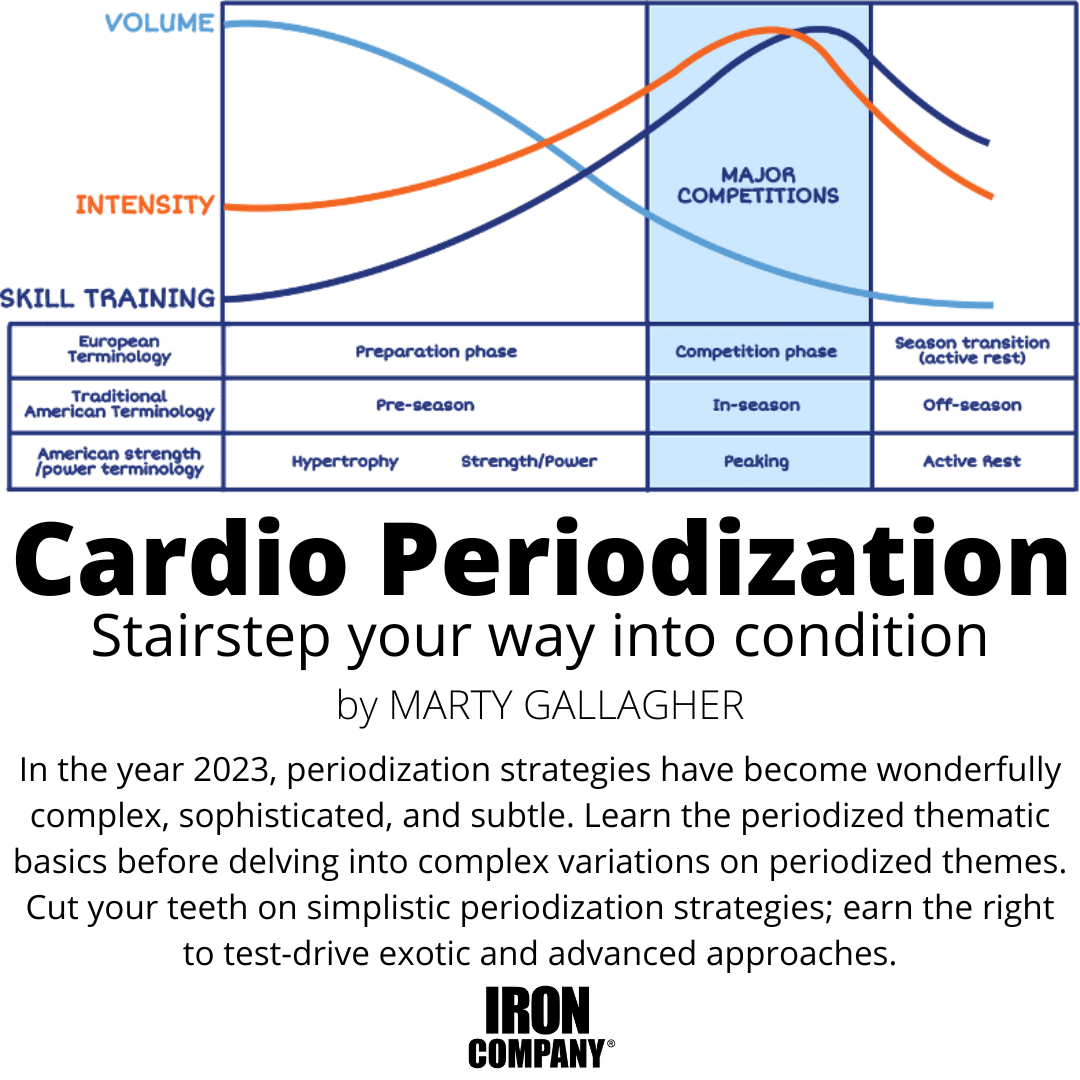
Cardio Training Periodization
Cardio Training Periodization - Stairstep your way into condition
In the year 2023, cardio periodization strategies have become wonderfully complex, sophisticated, and subtle. Learn the periodized thematic basics before delving into complex variations on periodized themes. Cut your teeth on simplistic periodization strategies; earn the right to test-drive exotic and advanced approaches.
Cardio training periodization is physiological preplanning. Portray an activity numerically and it can be periodized. First systematized by Iron Curtain weightlifting coaches, strength athletes have used periodization since the 1950s. Elite Russian and East German sprint coaches coopted, adapted, and adopted periodization tactics in the 1960s. Periodization made its way West in the 1970s, mostly through the efforts of Dr. Michael Yesiss, a Russian speaker who created the Soviet Sport Review. Periodization tactics proliferated for everything from volleyball to long jumping to cross country skiing.
Virtually every Olympic sport uses periodized variants. Periodized strategies have become increasingly complex as experts attempt to differentiate themselves, one from another, each adding their own (usually untried) unique wrinkle to the never-ceasing evolution of strategic periodization. The most elemental form of periodization is known as linear or straight-line periodization. Those new to periodization should begin with a straight-line periodized template; avoid being seduced by exotic variations, go simple, at least initially.
The first order of periodization is to select realistic goals. Without an overarching goal to work towards, every training session devolves into Ground Hog Day, every resistance training session becomes free-standing, independent, i.e., having no relationship to the preceding workout nor any to the succeeding training session. The Ground Hog Day trainee fills the available training time with whatever exercises they feel like performing using whatever number of sets and reps they feel like. No logging of results.
Periodization training requires goals to work towards. Select realistic goals and set goals into a timeframe. 12-weeks is the usual length for a transformative periodization “cycle.” Achieve the overarching goal by successfully and sequentially attaining weekly “mini-goals” in a wide range of periodized categories. Use periodization to…
- Increase a certain lift or lifts
- Improve a time or distance
- Modulate bodyweight/improve body fat percentile/add lean muscle mass
- Peak strength & power for a competition or event
- Peak overall athletic performance using a broader (nutrition, Mind, recovery) periodized template
- Stairstep endurance/fitness upward
- Periodize the “off-season,” have a plan when not competition prepping
Periodization sanctions rest and recovery: periodization makes rest and recovery an artform; the quicker the athlete can fully and completely recover the more sessions accumulated in the same timeframe: an athlete able to recover fully from a result-producing session in five days accumulates six training sessions every 30 days. Those that need seven days to recover accumulate four result-producing sessions per month. The athlete that needs ten days to fully recuperate accumulates three sessions per month. Periodization is as much about the gaps between the training sessions as the content of the sessions themselves.
Apply periodization tactics to cardiovascular conditioning. By “strapping up” and utilizing a heart rate monitor, the athlete can assign a numeric value to cardiovascular intensity and in doing so enables the use of periodization. The heart rate monitor allows the trainee to assign a numeric value to how hard the heart is working (intensity) in relation to the type and kind of exercise performed.
We have created a hypothetical periodized cardio workout template for illustrative purposes: a 40-year-old business executive is seeking to get back into shape. His goals, expectations, and timeframe are all realistic. In addition to this 10-week periodized cardiovascular training schedule, he has an equally systematic approach to resistance training. The aerobic and resistance training is wedded to a nutrient-dense, organic, nutritional regimen.
Overarching goals for 10-week/70-day periodized cycle…
- lose twenty-five pounds of body fat: add back five pounds of muscle, 20-pound bathroom scale reduction
- increase measurable strength in each of the “core four” lifts: squat, bench press, deadlift, overhead press
- improve cardio conditioning: commence with powerwalking; mid-cycle morph into jogging
- detoxify: switch out refined carbs, fast-food, sugar foods, for nutrient-dense organic super foods
- habit modification: disciplined nutrition and enforced rest underpins savage, consistent training
- adherence is critical: enthusiasm trumps willpower, enthusiasm springs from measurable results
Ten-week Periodized Cardio Exercise Template: stair-stepping fitness upward
| Week | Frequency | Duration | Intensity | Calories Burned | Bodyweight | Mode |
| 1 | 3 | 15 | 60% (108) | 150 | 198 | Power Walking |
| 2 | 3 | 17 | 62% (112) | 170 | 196 | " |
| 3 | 4 | 19 | 65% (117) | 230 | 194 | " |
| 4 | 4 | 21 | 67.5% (122) | 250 | 192 | " |
| 5 | 5 | 23 | 70% (126) | 275 | 190 | Jogging |
| 6 | 5 | 25 | 72.5% (131) | 300 | 188 | " |
| 7 | 6 | 27 | 75% (135) | 330 | 186 | " |
| 8 | 6 | 29 | 77.5% (140) | 360 | 184 | " |
| 9 | 7 | 30 | 80% (144) | 400 | 182 | " |
| 10 | 7 | 30 | 80% (144) | 400 | 180 | " |
Our hypothetical trainee has a class reunion in three months. The individual was a former athlete and has dormant muscle memory to reactivate. The goal is to methodically shave two pounds a week off his bodyweight while simultaneously increasing his lean muscle mass via thrice weekly, hypertrophy-inducing, low-volume, high-intensity progressive resistance training sessions.
Mobilize and oxidize stored body fat through the careful coordination of disciplined dieting and regularly occurring cardiovascular exercise. The final fourteen days of the 70-day cycle require daily 30-minute sessions at 80% of ARHR max; the trainee must tool along at an average of 144-beats per minute for thirty straight minutes. Ten weeks earlier, the cycle commenced with three 15-minute sessions averaging a paltry 108 beats per minute.
The Intensity column denotes the target age-related heart rate maximum as a percentile. The bracketed number is the actual heart rate required for a 40-year-old to attain the target percentile for each weekly session. The age-related-heart-rate maximum for a 40-year-old is 180 beats per minute. In week #1, our trainee seeks to powerwalk for 15 minutes three times a week averaging 108 beats per minute (the ‘floor’) for each of the 15 minutes of the session, this to attain the targeted 60% of age-related-heart-rate max average. If the heart rate dips below 108, he picks up the pace. Conversely, if the heart rate soars to say 135 while climbing a hill, he backs off. Bodyweight weigh-ins occur at the end of the training week.
One common phenomenon: when the out-of-shape suddenly begin training correctly (not too much, not too little, not too intense, not too mild) and eating correctly, switching out chemically laden insulin-spiking foodstuffs for nutrient-dense organic foods, detoxification occurs. In addition to being more muscular and leaner, the trainee becomes heathier and more energized, this as a direct result of detoxing.
Are you periodizing resistance training? Are you periodizing aerobic training? Are you periodizing body composition manipulations? Are you detoxing? You should be. Set goals, pick a timeframe, reverse-engineer weekly mini goals. Eat the periodized elephant one bite at a time. There is a difference between exercising and training; exercising is movement and motion without forethought or reflection; training requires thought and planning. And adherence.
Once a thoughtful, realistic, multidimensional, periodized template is created, we hold ourselves accountable to making the infinitesimally small weekly improvements. Inflight corrections, refinements, and adjustments are made along the way. The trainee ultimately arrives at predetermined, overarching periodized goal, physically renovated, psychologically revitalized. Learn how to periodize. Avoid the gerbil wheel that is exercise Ground Hog Day.
About the Author - Marty Gallagher
As an athlete Marty Gallagher is a national and world champion in Olympic lifting and powerlifting. He was a world champion team coach in 1991 and coached Black's Gym to five national team titles. He's also coached some of the strongest men on the planet including Kirk Karwoski when he completed his world record 1,003 lb. squat. Today he teaches the US Secret Service and Tier 1 Spec Ops on how to maximize their strength in minimal time. As a writer since 1978 he’s written for Powerlifting USA, Milo, Flex Magazine, Muscle & Fitness, Prime Fitness, Washington Post, Dragon Door and now IRON COMPANY. He’s also the author of multiple books including Purposeful Primitive, Strong Medicine, Ed Coan’s book “Coan, The Man, the Myth, the Method" and numerous others. Read the Marty Gallagher Biography for a more in depth look at his credentials as an athlete, coach and writer.



